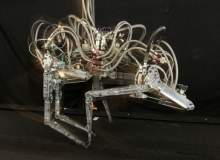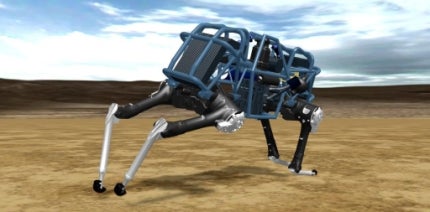
Boston Dynamics has carved a name for itself in the field of military robotics after the company’s BigDog robot, developed in conjunction with DARPA, demonstrated a multitude of impressive capabilities during testing. Now it’s the turn of the Cheetah to steal the headlines.
Funded by DARPA’s Maximum Mobility and Manipulation (M3) programme, which is focused on working towards making fundamental advances in theoretical and experimental robotics, Cheetah is a four-legged robot capable of achieving high speeds through its animal-like design. The robot has an articulated back that flexes back and forth as it moves to increase its stride and running speed, based on the actual movements of a wild cheetah.
The development of the Cheetah has now not only seen it smash its own land speed record for legged robots set just over six months ago, but also surpass the speeds reached by two-time Olympic 100m sprint champion, Jamaican sprinter Usain Bolt. During Bolt’s record-breaking 100m run in 2009 which he finished in 9.58 seconds, his peak speed set during his best 20m split was 27.78mph. During laboratory testing on a high-speed treadmill, Boston Dynamics clocked Cheetah’s fastest 20m split at 28.3mph.
Refined algorithms help smash record

A concept image of the WildCat, an untethered variant of the Cheetah capable of operating outdoors. Image courtesy of Boston Dynamics.
The results come just six months after the Cheetah set a new land speed record for legged robots, clocking a speed of 18mph. This was achieved by the engineering team refining control algorithms that coordinate the robot’s leg and back motions, while also increasing the installed power.
How well do you really know your competitors?
Access the most comprehensive Company Profiles on the market, powered by GlobalData. Save hours of research. Gain competitive edge.

Thank you!
Your download email will arrive shortly
Not ready to buy yet? Download a free sample
We are confident about the unique quality of our Company Profiles. However, we want you to make the most beneficial decision for your business, so we offer a free sample that you can download by submitting the below form
By GlobalDataHowever, the robotic cheetah is confined a high-speed treadmill and is powered via an off-board hydraulic pump. Using a boom-like device to keep the robot central on the treadmill, the Cheetah will need to ditch its tether before it can be considered a feasible option for service.
Related project
PETMAN (Protection Ensemble Test Mannequin) Humanoid Military Robot, United States of America
Protection Ensemble Test Mannequin (PETMAN) is a humanoid robot being developed for the US Army to test the special clothing used by soldiers for protection against chemical warfare agents.
Boston Dynamics chief robotics scientist Dr. Alfred Rizzi said: "Achieving 28mph on the treadmill is quite a challenge and accomplishment, for which I commend our robotics team. But our goal is to create a robot that moves freely outdoors while it runs fast. We are building an outdoor version that we call WildCat, that should be ready for testing early next year."
DARPA program manager Gill Pratt echoed Rizzi’s sentiments, adding: "What DARPA is doing with its robotics programs is attempting to understand and engineer into robots certain core capabilities that living organisms have refined over millennia of evolution: efficient locomotion, manipulation of objects and adaptability to environments.
"Our Cheetah bot borrows ideas from nature’s design to inform stride patterns, flexing and unflexing of parts like the back, placement of limbs and stability. What we gain through Cheetah and related research efforts are technological building blocks that create possibilities for a whole range of robots suited to future Department of Defense missions," added Pratt.
Future development and deployment
In order to support the untethered, outdoor WildCat robot, an onboard engine and further improvements to the robot’s actuators have been planned. Should the operational testing scheduled for 2013 go to plan, Boston Dynamics see the Cheetah as having a ‘wide range of military and civilian applications’, with the company highlighting emergency rescue and disaster response as particular areas of interest.
The Cheetah’s ability to use terrain that limits the use of conventionally wheeled and tracked vehicles, distinctly similar to how Boston’s other incarnation BigDog has demonstrated, makes it of particular use to a military that is becoming increasingly deployed in tough environments.



